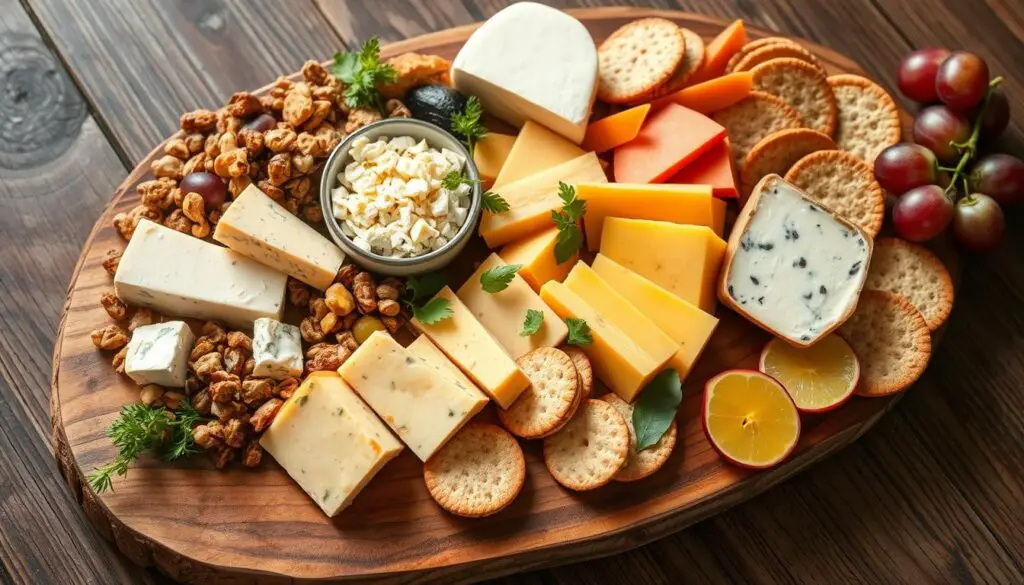Is Shredded Cheese Healthy? Nutritional Facts
Can shredded cheese really be part of a healthy diet, or does it have more downsides than upsides?
The debate about cheese’s nutritional value is ongoing. It’s especially true as cheese becomes more popular in many dishes. The 2020-2025 Dietary Guidelines for Americans suggest adults 19 to 50 need 1,000 milligrams of calcium daily. Cheddar cheese, with about 200 mg per ounce, can meet nearly a third of this need1.
Cheese is more than just calcium; it’s also a good source of protein, fat, potassium, and vitamin B12. With Americans eating about 42 pounds of cheese each year, knowing if shredded cheese is healthy is crucial2.
In this article, we’ll dive into shredded cheese’s health benefits, nutritional profile, and how it fits into a balanced diet.
Key Takeaways
- Cheddar cheese contains approximately 200 mg of calcium per ounce, fulfilling a part of the daily calcium requirement.
- Moderation is recommended, with a serving size of 1 ounce being common for daily cheese intake.
- Cheese provides essential nutrients such as protein, potassium, and vitamin B12, contributing to a balanced diet.
- Aged and hard cheeses are low in lactose, making them suitable for many who are lactose intolerant.
- Shredded cheese offers convenience but may have added cellulose and slightly altered flavors compared to block cheese3.
Understanding Shredded Cheese
Shredded cheese is cheese grated into small pieces. It’s easy to use in many recipes. Cheddar, mozzarella, and Monterey Jack are popular for their flavors and melting ability.
What is Shredded Cheese?
Shredded cheese may have additives to prevent clumping. This is important for cooking. Block cheese lasts longer than shredded cheese because it has less surface area exposed to air.
Popular Types of Shredded Cheese
Cheddar is the most known shredded cheese. Mozzarella and Monterey Jack are also favorites for melting. Hard cheeses like provolone and Parmesan are great for shredding at home.
Brands like Kraft, Tillamook, and Sargento use additives to keep textures right. The FDA says these additives are safe to eat4.
Is Shredded Cheese Healthy?
To figure out if shredded cheese is healthy, we need to look at its nutritional content. Different types of shredded cheese have different amounts of nutrients. For instance, Cheddar cheese has about 7g of protein and 185mg of calcium in every 25g serving. This is good for keeping bones strong56.
Block cheese often has fewer additives than pre-packaged shredded cheese. This makes block cheese a better choice for some5.
Nutritional Profile of Shredded Cheese
The nutritional values of shredded cheese vary. Gouda has 5.1g of saturated fat and 6.7g of protein in every 25g serving. Parmesan, on the other hand, has a lot of calcium, 256mg6. These nutrients help with bone health and muscle repair.
Health Benefits of Eating Cheese
Eating cheese in moderation can be good for you. It helps keep your mouth alkaline, which can fight cavities5. Cheeses like Mozzarella and Feta have less saturated fat, making them a healthier option without losing flavor6.
Recent studies suggest that cheese’s saturated fat might not harm your heart when part of a balanced diet5.
Nutritional Value of Shredded Cheese
Shredded cheese is loved for its taste and ease of use. But, knowing its nutritional facts is key for smart eating. Cheddar cheese, for example, has about 120 calories and 10g of fat in one ounce7. This makes it a good choice for adding flavor without carbs, as it has none7.
Caloric Content and Macronutrients
Looking at macronutrients, cheddar cheese gives 7g of protein per ounce, helping meet daily protein needs7. Compared to mozzarella, cheddar has more calories and fat8. It also has about 6g of saturated fat per ounce, more than mozzarella8. This is good for those wanting more protein on low-carb diets.
Vitamins and Minerals Found in Cheese
Cheddar cheese is packed with vitamins and minerals. It has 20% of the daily value for calcium in one ounce7. It also has 201.6mg of calcium, 95.7mcg of Vitamin A, and 0.3mcg of Vitamin B127. Plus, it has phosphorus and zinc, important for the body8. These nutrients make shredded cheese a great part of a healthy diet.
| Nutrient | Amount per 1 oz (28g) | Daily Value (%) |
|---|---|---|
| Calories | 120 | – |
| Protein | 7g | – |
| Fat | 10g | – |
| Saturated Fat | 6g | – |
| Calcium | 201.6mg | 20% |
| Vitamin A | 95.7mcg | 10% |
| Vitamin B12 | 0.3mcg | – |
| Phosphorus | Amount varies | – |
Processed Cheese vs. Natural Cheese
It’s important to know the differences in cheese between processed and natural cheese. Processed cheese, like American cheese, is made by melting and mixing different natural cheeses. This makes it smooth and keeps it fresh longer. Natural cheese, on the other hand, has more protein and ages longer to get its unique taste and texture9.
Processed cheese often has more sodium, which is a drawback for those watching their health9. Natural cheese is packed with nutrients but can spoil if exposed to too much heat or sunlight. Processed cheese is softer and creamier, but it’s made quicker without aging9. There are also organic processed cheese options that are free from artificial additives, appealing to those seeking healthier choices10.

A slice of American cheese has about 60 calories, 4 grams of fat, and 4 grams of protein. Cheddar cheese, on the other hand, has 113 calories, 9 grams of fat, and 7 grams of protein11. Processed cheese can last up to six months in the fridge, while cheddar cheese lasts 4 to 6 months unopened and 3 to 4 weeks once opened11. These facts highlight the differences in cheese that affect our diet choices.
| Type of Cheese | Calories | Total Fat (g) | Protein (g) | Shelf Life (Refrigerated) |
|---|---|---|---|---|
| American Cheese (1 slice) | 60 | 4 | 4 | About 6 months unopened |
| Cheddar Cheese (1 ounce) | 113 | 9 | 7 | 4 to 6 months unopened; 3 to 4 weeks opened |
With this knowledge, people can choose the right cheese for their health and taste preferences.
Saturated Fats in Shredded Cheese
Saturated fats make up about 60% of shredded cheese’s fat. Knowing about saturated fats helps us make better food choices, especially for our heart health. Old advice was to eat less saturated fat to avoid heart disease.
The American Heart Association says we should eat no more than 5% to 6% of our daily calories from saturated fats. That’s about 13 grams for a 2,000-calorie diet12. This shows how important it is to watch how much fat we get from all foods, including shredded cheese.
Understanding Saturated Fats
The amount of saturated fat in cheese can change a lot. For example, cheddar cheese has about 9 grams of saturated fat per ounce, while mozzarella has around 5 grams13. This means we need to check the labels to pick healthier options.
Choosing lower-fat cheeses, like part-skim or “lite” ones, can help cut down on saturated fats. This is key for those trying to follow guidelines without giving up cheese.
How Saturated Fats Affect Health
Experts still talk about the health effects of saturated fats. Some studies say that saturated fats in full-fat dairy, like cheese, might not be as bad for our hearts as thought13. For people at risk of heart disease, it’s even more important to watch their cholesterol intake, aiming for no more than 200 mg a day.
But, eating full-fat cheese in small amounts might actually help our cholesterol levels. By choosing quality cheese and watching our portions, we can enjoy dairy while keeping an eye on our saturated fat intake14.
Cheese Alternatives and Healthy Snacks
For those facing lactose intolerance, many cheese alternatives are available. Aged and hard cheeses have less lactose, making them good choices. Plant-based cheeses from cashews, soy, and coconuts are also popular. They are often lower in saturated fat and may have calcium and protein1516.
Options for Lactose Intolerance
Many people with lactose intolerance still enjoy snacks rich in iron and calcium. Cottage cheese is a low-fat, high-protein option17. Greek yogurt, with its probiotics, can replace cream cheese in recipes. It’s good for digestion and has less fat17.
Low-fat Cheese Choices
Looking for low-fat cheese is a smart way to add healthy snacks to your diet. Almond cheese, for example, has healthy fats and fewer calories than regular cheese17. Goat cheese, which is easier to digest and has less lactose, paired with whole-grain crackers makes a tasty snack. Snacks like dark chocolate with almonds or cucumbers with hummus keep you energized and balanced16.

Portion Control When Consuming Cheese
Adding cheese to your diet needs careful thought about how much you eat. Cheese is full of calcium, protein, and fats, but it also has a lot of calories and saturated fats18. It’s important to eat it in moderation to get its benefits without the negative effects of too much.
Understanding Serving Sizes
A standard cheese serving is about 1.5 ounces of hard cheese or 25 grams18. For cheeses like cottage cheese, feta, and mozzarella, aim for 1 to 2 ounces to keep calorie intake in check19. It’s best to eat small amounts of high-fat cheeses to avoid gaining weight, as they are very calorie-dense20.
Moderation in a Balanced Diet
Eating cheese in moderation is key to a balanced diet. Cheese is often paired with high-calorie foods like bread and pasta, making it harder to control portions18. Soft cheeses like cottage cheese or fresh mozzarella have fewer calories than hard cheeses like parmesan18. Pairing cheese with protein-rich foods like legumes and meats can add nutrients without too many calories20.
Most cheeses also have a lot of salt, which can cause water retention18. Using the ‘one-plate’ rule can help manage cheese portions and make it a satisfying part of your meal20.
Common Concerns About Shredded Cheese
Shredded cheese is popular for its convenience. But, it also raises some concerns. One big issue is cellulose in shredded cheese, used to prevent clumping and extend shelf life. Cellulose comes from plants and is safe to eat. But, many think all additives are bad, leading to confusion about cheese.
Cellulose and Additives in Preshredded Cheese
Preshredded cheese costs more because of extra processing and packaging21. There are not many cheese types available, so most pre-shredded cheese is cheddar or mozzarella21. The shredding process can make cheese more prone to bacteria, which is a health risk21. But, cellulose is often misunderstood; it improves texture without harming safety.
Misconceptions About Cheese and Weight Gain
Many think cheese makes you gain weight. But, some studies say full-fat dairy might help with weight management because it’s filling. Enjoying cheese in moderation as part of a balanced diet can be satisfying without causing weight gain. This is key for those worried about cheese and weight gain; knowing how much to eat is important.
Debunking these common worries helps people make better cheese choices. This way, they can enjoy cheese’s flavor and nutritional benefits2223.
Conclusion
Shredded cheese can be a healthy part of your diet if eaten in the right amounts. It’s full of protein and calcium, which are good for your bones. It might also help protect your heart.
But, it’s important to choose the right kind of cheese. Look for natural and low-fat options. This helps avoid too much saturated fat and sodium24.
Research shows that eating cheese in moderation is okay. It doesn’t raise the risk of heart disease or diabetes much24. It can even help your gut health and weight control, making it tasty and healthy25.
Adding shredded cheese to your meals can make them more enjoyable. It’s a way to add flavor while staying healthy.
To answer if shredded cheese is healthy, it depends on how you eat it. Choose wisely and control your portions. This way, you can enjoy cheese without harming your health. For more details, check out this article26.







